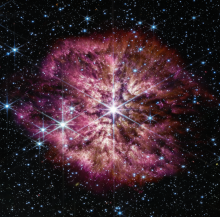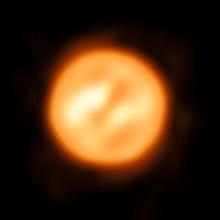Listen to today's episode of StarDate on the web the same day it airs in high-quality streaming audio without any extra ads or announcements. Choose a $8 one-month pass, or listen every day for a year for just $30.
You are here
Moon and Antares
Predicting the future isn’t easy — just ask your local weather forecaster. But scientists recently got some help in predicting the future of supergiant stars.
The help came in the form of a supernova — an exploding supergiant in a pair of merging galaxies about 60 million light-years away. A planet-hunting space telescope was pointing that way at the time of the blast. It was taking pictures every 30 minutes, so it provided a time-lapse view of the star before and after it erupted. That was the first time astronomers got to watch a supernova so close to its actual explosion.
In addition, Hubble Space Telescope and other telescopes in space and on the ground turned toward the galaxy within hours or even minutes. And over the following weeks, astronomers poked through older observations of the galaxy to see what the star looked like before the outburst.
Such a detailed view could tell astronomers what to look for when a supergiant is about to become a supernova — helping them predict the future.
Several supergiants thought to be close to the end are in good view now. There’s Betelgeuse, the bright shoulder of Orion the hunter, which is high in the south at nightfall. And there’s Antares, the heart of the scorpion, which is quite close to the Moon at first light the next couple of days. Both stars could explode any time within the next hundred thousand years — even tonight.
More about supernovas tomorrow.
Script by Damond Benningfield






